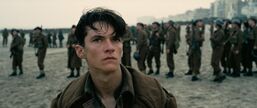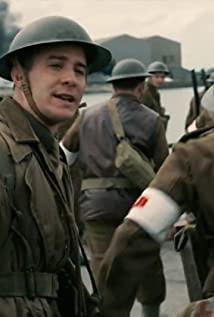In Nolan's 2006 film "Deadly Magic", there is a scene: the magician puts a bird cage with a bird on the table, and then covers it with a white cloth. He presses it firmly and then lifts the white cloth. The bird disappeared with the bird cage. The audience applauded and admired the magic of the magic, only a little boy cried out loudly with a "wow": "He killed the bird!". When everyone was amazed by the mental and sensory impact brought by surrealism, Nolan let the little boy discover the cruelty and cold blood hidden behind the magical illusion: this brilliant performance was exchanged for a living life. If there is anything amazing about the concept of "Dunkirk" ten years later, it is that Nolan played the role of this little boy in his mind: when the audience expects to see a process of ups and downs on the screen, When facing fierce battles between the two sides, thrilling visual effects, and an evil ending, and eager to get the excitement and excitement of the senses from the scenes of repeated battles, fights and massacres between the two armies, Nolan uses the typical British style. The gloomy and quiet tone tells us: Even on the movie screen, war should not be just a carnival visual feast that can be enjoyed or a victory or defeat game full of family and country history. It is a despair shrouded by the cruel law of the jungle. The survival experience is an instinct of courage, courage and sacrifice. This is why he created a bold and challenging setting in the creation of "Dunkirk" that can disappoint many viewers who are looking forward to seeing the "conventional warfare movie": it should be fierce and aggressive. Almost the entire time the enemy army was hidden from view, what we saw was the miracle of how groups of creatures were surrounded and squeezed on the beach with their lives hanging by a thread. The routines that may have been seen in a war movie no longer exist in Dunkirk: we neither need a scene of a fierce battle of guns and guns, nor an overall description of the strategic confrontation between the generals of the two armies, let alone The typified narrative structure with a three-act play structure, even the macro narrative of military operations is almost omitted. What Nolan needs here is only a few viewpoints and actions in viewpoints that can be directly cut into the micro-portrait to highlight his intentions. This is why Nolan repeatedly watched Robert Bresson’s "Death Row Escape" and "Pickpocket" before the filming started. Bresson once created the purest cinematic image in film history: there is no extra word, his characters have only constant actions. All the evolution, continuation and even reversal of thoughts, emotions, and mental states are realized in uninterrupted silent actions. At this time, Nolan, who has given up on the macro narrative, needs such an action scheduling soul and skills. Open in the video In the first ten minutes after the game, the first main character, Phine Whitehead, barely said a single line, but he ran on the streets of the town, staggered on the beach, and pretended to be a stretcher to transport the wounded on board. A series of actions put his intense desire to survive mixed with extreme tension and timidity on the screen in a silent manner. At this moment, Nolan almost moved Bresson's soul to the beach of Dunkirk. Twenty years ago, Terrence Malick once shot an extraordinary World War II film "Thin Red Line". The film did not set the central character and the core plot, but used the camera as a needle-and-threaded medium to connect many characters and Their inner fluctuations used their different perspectives to collage the overall picture of the war, and placed the poetic emotional atmosphere above the war narrative, which became the main theme of the film. No in-depth text description of the subject, but a scatter perspective collage technique to capture and combine the dynamics of many characters to form an overall breath that runs through the film. This is the first time that the famous Soviet director Vertov introduced him. The brand-new method of film composition created in his business card "The Man with a Camera" (1929). And he even called the vision that is unique to the film itself, which is formed by freely switching between different objects to be shot from the perspective of a single person, as the "cinematic eye", that is, the camera uses a motion beyond the physical movement after getting rid of the natural state of human observation. Way (editing) to form a spiritual and intellectualized vision. Pasolini then summarized it as the state of "free indirect discourse" in the film, and asserted that only through it can the poetry in the film image be formed. The French philosopher Deleuze simply defined it as a pure "film consciousness" to distinguish it from the repeated penetration of literature, drama and plastic arts into film. Nolan follows Malik's footsteps and brings Vertov's "movie-eye" into a personalised visual description of war. He did not waste any pen and ink on the dramatic routines that can evoke textual narratives: in the film we can’t see the characters’ personal backgrounds, we don’t know anything about their experiences in past wars, and we can’t even find out about the characters’ personalities. Describe clearly. After a few words on the subtitles of the macro war process, Nolan directs these three different groups of characters (soldiers waiting to retreat and officers in command of the retreat, civilian ships to rescue and pilots of Spitfire fighters in air interception). They plunged into the besieged and blocked Dunkirk beach, allowing their emotions and reason to be instantly displayed in the extreme environment of survival in despair. We may still be able to see certain characteristics of Nolan’s basic narrative conception, such as three different qualitative time structures (one week, one day, and one hour) The way of being cut into fragments and connected to each other continues his "rebellion" against the continuity of the time sequence of the film. The fragmented effect of narration itself is a break with the structure of the three-act drama, especially under the single and clear overall event of "retreat", it gives the visualized scatter perspective expression with extremely free expression space. Thus, we see Nolan handing "Dunkirk" to the camera carrying the "Cinema Eye", which is like a seagull hovering in the air, between the three groups of characters and their heterogeneous time and space. Shuttle back and forth, combining what you saw at the passing moment into a dynamic image of a surge of emotional power. As Pasoliniso said, poetry is produced by this penetrating camera perspective in the jump and connection between the souls of different characters. Maybe we can't ignore the other level of space brought by music. If you look at the music that accompanies "Dunkirk" in a habitual way, you may dislike it as the overflow of the soundtrack. But if we look back and appreciate Nolan's intention to create a bird's perspective, we will find that because of the continuous presence of music, we maintain the leap-forward posture of "shuttle between souls" from beginning to end. It is the complete outside space created by music around all the “fragments” that helps us maintain a sufficiently high “flying view” to avoid being completely submerged or confused with any micro-narrative perspective. In the final analysis, music here is not just a foil for the auxiliary role of the picture. Its intrepidity and "overwhelmingly dominant" is a key step in Nolan's break with the traditional single grand narrative. "Dunkirk" is a movie that made us admire Nolan. Prior to this, he had been struggling between his British film bloodline and Hollywood's modular expression, not wanting to completely abandon his demand for personal characteristics, but also had to bow to the shackles of the American commercial film system. This makes every movie he shoots in Hollywood carries an indelible eclectic tone. At the same time, his straightforward and uncontrollable preaching impulse in film creation before has become an insurmountable ailment, which has made his complex narrative structure constructed with great effort and the refinement of technical expression methods become The aimlessness of the craftsmanship. The setting of "Flying Bird Scatter Perspective" in "Dunkirk" allows us to see his potential as a film director rather than a "storyteller". He finally realized that the "problem" of a film cannot be solved in the scope of narration alone. Only by breaking through the bottleneck of "storytelling" and giving the image enough free space for expression can the film's conception be different. Level. After all, Vertov became "realistic" through "The Man with a Camera" The definition did not design a storyline for every subject. At this time, the textual expression may have become an auxiliary means of image ideology: on the train near the end of the film, two surviving soldiers read Churchill's speech in the newspaper. The argument that "escape is victory" seemed to make us see Nolan who couldn't help but preach to the audience in an instant. But the picture immediately changed and we returned to Dunkirk, shooting down several enemy planes but the Spitfire that ran out of fuel landed on the beach in an incomparably graceful posture, and Tom Hardy stepped off the plane in the afterglow of the setting sun. He took off his helmet and calmly faced the encircled German soldiers, and his personal heroism burst out in an instant. Only then did we realize that it was precisely the ideogram repeated by the two soldiers that brought the subsequent picture to the peak of emotional appeal. Here the image no longer appears as a footnote to the text, it is the ultimate destination of meaning. And the final idea that Nolan gave to the film also surfaced in the interplay of text and images: it has nothing to do with wars that affect the course of history and reflections on them, and it has nothing to do with the fate of a certain ideological camp. It does not want to celebrate the sense of honor and mission in the framework of the family and country, nor is it interested in the inevitable outcome of the struggle between justice and evil; "Dunkirk" is based on the background of the sea, land and air under extreme hardship, and different groups of people in the "flying bird perspective" The state of existence, the thickness of its center of gravity has passed the in-depth narratives of war history that we usually focus on, and presents a purely cinematic dynamic reproduction. What it highlights is the heroism with a strong personal meaning-regardless of the victory of the war. Negative or not, people who fight bravely to save their own lives and others are heroes. Such a theme is sufficient to crush any other expressions that are entangled in history, fate, honor and disgrace, and survival while ignoring individual values. The narrative retreats and the image comes first, and at the same time it gives the image the expressive power that goes far beyond the surface text. For Nolan, "Dunkirk" is a qualitative leap in the concept of film. The scene of the Spitfire gliding across the sky and landing on the beach in Xiaguang became the most touching moment of personal heroism of the year. The Spitfire landed on the beach with an extremely graceful attitude. Tom Hardy, who got off the plane, took off his helmet in the afterglow of the setting sun and calmly faced the encircling German soldiers. His personal heroism was bursting all over in an instant. Only then did we realize that it was precisely the ideogram repeated by the two soldiers that brought the subsequent picture to the peak of emotional appeal. Here the image no longer appears as a footnote to the text, it is the ultimate destination of meaning. And the final idea that Nolan gave to the film also surfaced in the interplay of text and images: it has nothing to do with wars that affect the course of history and reflections on them, and it has nothing to do with the fate of a certain ideological camp. It does not want to celebrate the sense of honor and mission in the framework of the family and country, nor is it interested in the inevitable outcome of the struggle between justice and evil; "Dunkirk" is based on the background of the sea, land and air under extreme hardship, and different groups of people in the "flying bird perspective" The state of existence, the thickness of its center of gravity has passed the in-depth narrative of war history that we usually focus on, and presents a purely cinematic and dynamic reproduction. What it highlights is the heroism with a strong personal meaning-no matter whether the war wins Negative or not, people who fight bravely to save their own lives and others are heroes. Such a theme is sufficient to crush any other expression that is entangled in history, fate, honor and disgrace, and survival while ignoring individual values. The narrative retreats and the image comes first, and at the same time it gives the image the expressive power that goes far beyond the surface text. For Nolan, "Dunkirk" is a qualitative leap in the concept of film. The scene of the Spitfire gliding across the sky and landing on the beach in Xiaguang became the most touching moment of personal heroism of the year. The Spitfire landed on the beach with an incomparably graceful posture. Tom Hardy, who got off the plane, took off his helmet in the afterglow of the setting sun and calmly faced the encircled German soldiers. His personal heroism was bursting all over in an instant. Only then did we realize that it was precisely the ideogram repeated by the two soldiers that brought the subsequent picture to the peak of emotional appeal. Here the image no longer appears as a footnote to the text, it is the ultimate destination of meaning. And the final idea that Nolan gave to the film also surfaced in the interplay of text and images: it has nothing to do with wars that affect the course of history and reflections on them, and it has nothing to do with the fate of a certain ideological camp. It does not want to celebrate the sense of honor and mission in the framework of the family and country, nor is it interested in the inevitable outcome of the struggle between justice and evil; "Dunkirk" is based on the background of the sea, land and air under extreme hardship, and different groups of people in the "flying bird perspective" The state of existence, the thickness of its center of gravity has passed the in-depth narratives of war history that we usually focus on, and presents a purely cinematic dynamic reproduction. What it highlights is the heroism with a strong personal meaning-regardless of the victory of the war. Negative or not, people who fight bravely to save their own lives and others are heroes. Such a theme is sufficient to crush any other expression that is entangled in history, fate, honor and disgrace, and survival while ignoring individual values. The narrative retreats and the image comes first, and at the same time it gives the image the expressive power that goes far beyond the surface text. For Nolan, "Dunkirk" is a qualitative leap in the concept of film. The scene of the Spitfire gliding across the sky and landing on the beach in Xiaguang became the most touching moment of personal heroism of the year. There is a purely cinematic dynamic reappearance, highlighting the heroism with a strong personal meaning-whether the war is won or lost, the person who fights bravely to save himself and others is a hero. Such a theme is sufficient to crush any other expression that is entangled in history, fate, honor and disgrace, and survival while ignoring individual values. The narrative retreats and the image comes first, and at the same time it gives the image the expressive power that goes far beyond the surface text. For Nolan, "Dunkirk" is a qualitative leap in the concept of film. The scene of the Spitfire gliding across the sky and landing on the beach in Xiaguang became the most touching moment of personal heroism of the year. There is a purely cinematic dynamic reappearance, highlighting the heroism with a strong personal meaning-whether the war is won or lost, the person who fights bravely to save himself and others is a hero. Such a theme is sufficient to crush any other expression that is entangled in history, fate, honor and disgrace, and survival while ignoring individual values. The narrative retreats and the image comes first, and at the same time it gives the image the expressive power that goes far beyond the surface text. For Nolan, "Dunkirk" is a qualitative leap in the concept of film. The scene of the Spitfire gliding across the sky and landing on the beach in Xiaguang became the most touching moment of personal heroism of the year.
View more about Dunkirk reviews











